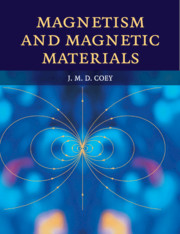Book contents
- Frontmatter
- Contents
- List of tables of numerical data
- Preface
- Acknowledgements
- 1 Introduction
- 2 Magnetostatics
- 3 Magnetism of electrons
- 4 Magnetism of localized electrons on the atom
- 5 Ferromagnetism and exchange
- 6 Antiferromagnetism and other magnetic order
- 7 Micromagnetism, domains and hysteresis
- 8 Nanoscale magnetism
- 9 Magnetic resonance
- 10 Experimental methods
- 11 Magnetic materials
- 12 Applications of soft magnets
- 13 Applications of hard magnets
- 14 Spin electronics and magnetic recording
- 15 Special topics
- Appendices
- Formula index
- Index
- Tables, conversions, constants and units
13 - Applications of hard magnets
Published online by Cambridge University Press: 05 June 2012
- Frontmatter
- Contents
- List of tables of numerical data
- Preface
- Acknowledgements
- 1 Introduction
- 2 Magnetostatics
- 3 Magnetism of electrons
- 4 Magnetism of localized electrons on the atom
- 5 Ferromagnetism and exchange
- 6 Antiferromagnetism and other magnetic order
- 7 Micromagnetism, domains and hysteresis
- 8 Nanoscale magnetism
- 9 Magnetic resonance
- 10 Experimental methods
- 11 Magnetic materials
- 12 Applications of soft magnets
- 13 Applications of hard magnets
- 14 Spin electronics and magnetic recording
- 15 Special topics
- Appendices
- Formula index
- Index
- Tables, conversions, constants and units
Summary
Fail better
Samuel Beckett 1906–1989Permanent magnets deliver magnetic flux into a region of space known as the air gap, with no expenditure of energy. Hard ferrite and rare-earth magnets are ideally suited to generate flux densities comparable in magnitude to their spontaneous polarization Js. Applications are classified by the nature of the flux distribution, which may be static or time-dependent, as well as spatially uniform or nonuniform. Applications are also discussed in terms of the physical effect exploited (force, torque, induced emf, Zeeman splitting, magnetoresistance). The most important uses of permanent magnets are in electric motors, generators and actuators. Their power ranges from microwatts for wristwatch motors to hundreds of kilowatts for industrial drives. Annual production for some consumer applications runs to tens or even hundreds of millions of motors.
The flux density Bg in the airgap (equal to µ0Hg) is the natural field to consider in permanent magnet devices because flux is conserved in a magnetic circuit, and magnetic forces on electric charges and magnetic moments all depend on B.
A static uniform field may be used to generate torque or align pre-existing magnetic moments since г = m × Bg. Charged particles moving freely through the uniform field with velocity v are deflected by the Lorentz force f = qv × Bg, which causes them to move in a helix, turning with the cyclotron frequency (3.26) fc = qB/2πm.
- Type
- Chapter
- Information
- Magnetism and Magnetic Materials , pp. 464 - 493Publisher: Cambridge University PressPrint publication year: 2010
- 1
- Cited by

